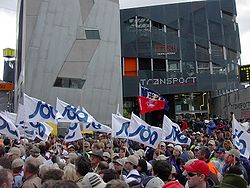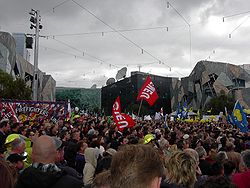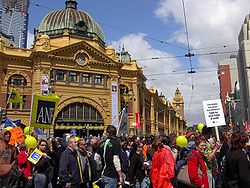
Australian industrial relations legislation national day of protest, 2005
Encyclopedia

Australia
Australia , officially the Commonwealth of Australia, is a country in the Southern Hemisphere comprising the mainland of the Australian continent, the island of Tasmania, and numerous smaller islands in the Indian and Pacific Oceans. It is the world's sixth-largest country by total area...
on 15 November 2005, to protest against the industrial relations legislation being introduced by the government of Prime Minister
Prime Minister of Australia
The Prime Minister of the Commonwealth of Australia is the highest minister of the Crown, leader of the Cabinet and Head of Her Majesty's Australian Government, holding office on commission from the Governor-General of Australia. The office of Prime Minister is, in practice, the most powerful...
John Howard
John Howard
John Winston Howard AC, SSI, was the 25th Prime Minister of Australia, from 11 March 1996 to 3 December 2007. He was the second-longest serving Australian Prime Minister after Sir Robert Menzies....
. The day was organised by the Australian Council of Trade Unions
Australian Council of Trade Unions
The Australian Council of Trade Unions is the largest peak body representing workers in Australia. It is a national trade union centre of 46 affiliated unions.-History:The ACTU was formed in 1927 as the "Australian Council of Trade Unions"...
(ACTU) and its state, territory and local affiliates, with the support of the Australian Labor Party
Australian Labor Party
The Australian Labor Party is an Australian political party. It has been the governing party of the Commonwealth of Australia since the 2007 federal election. Julia Gillard is the party's federal parliamentary leader and Prime Minister of Australia...
, the Australian Greens
Australian Greens
The Australian Greens, commonly known as The Greens, is an Australian green political party.The party was formed in 1992; however, its origins can be traced to the early environmental movement in Australia and the formation of the United Tasmania Group , the first Green party in the world, which...
, the Australian Democrats
Australian Democrats
The Australian Democrats is an Australian political party espousing a socially liberal ideology. It was formed in 1977, by a merger of the Australia Party and the New LM, after principals of those minor parties secured the commitment of former Liberal minister Don Chipp, as a high profile leader...
, and various other political and community organisations.
Estimates of the number of people taking part varied widely, with organisers claiming more than 500,000. Police and media estimates suggested that about 250,000 people took part in capital city rallies. Tens of Thousands of people also attended hundreds of meetings in rural and regional towns across Australia.
Government ministers such as John Howard and Industrial Relations Minister Kevin Andrews
Kevin Andrews (Australian politician)
Kevin James Andrews is an Australian politician and member of the Liberal Party of Australia. He is a member of the House of Representatives and was Minister for Immigration and Citizenship in the Howard Government, having previously been Minister for Employment and Workplace Relations from 7...
said they would ignore the protests. Howard said that in a year's time the legislation would be accepted. Andrews described the ACTU campaign as "irresponsible and hysterical." The Australian Chamber of Commerce and Industry
Australian Chamber of Commerce and Industry
The Australian Chamber of Commerce and Industry has been the peak council of Australian business associations for 105 years and traces its heritage back to Australia’s first chamber of commerce in 1826.Its motto is “Leading Australian Business.”...
said that "more than 95 per cent of workers ignored the call-out to join the protest."
Commonwealth Public Servants were prohibited from attending with one report saying "The Department of Employment and Workplace Relations has just advised agencies that [the national day of community protest] is a form of industrial action and as such access to leave and flex leave should not be given to employees wishing to attend."
In Melbourne
Melbourne
Melbourne is the capital and most populous city in the state of Victoria, and the second most populous city in Australia. The Melbourne City Centre is the hub of the greater metropolitan area and the Census statistical division—of which "Melbourne" is the common name. As of June 2009, the greater...
, the rally, at Federation Square
Federation Square
Federation Square is a civic centre and cultural precinct in the city of Melbourne, Victoria, Australia....
, was addressed by the Premier of Victoria, Steve Bracks
Steve Bracks
Stephen Philip Bracks AC is a former Australian politician and the 44th Premier of Victoria. He first won the electoral district of Williamstown in 1994 for the Australian Labor Party, and was party leader and Premier from 1999 to 2007....
, the ACTU President, Sharan Burrow
Sharan Burrow
Sharan Burrow is the General Secretary of the International Trade Union Confederation and a former President of the Australian Council of Trade Unions...
, and the ACTU Secretary, Greg Combet
Greg Combet
Gregory Ivan Combet AM MP is an Australian politician and trade unionist. He was Secretary of the Australian Council of Trade Unions between 2000 and 2007...
. In Brisbane
Brisbane
Brisbane is the capital and most populous city in the Australian state of Queensland and the third most populous city in Australia. Brisbane's metropolitan area has a population of over 2 million, and the South East Queensland urban conurbation, centred around Brisbane, encompasses a population of...
, the Premier of Queensland Peter Beattie
Peter Beattie
Peter Douglas Beattie , Australian politician, was the 36th Premier of the Australian state of Queensland for nine years and leader of the Australian Labor Party in that state for eleven and a half years...
and federal Labor Party Leader Kim Beazley
Kim Beazley
In the October 1998 election, Labor polled a majority of the two-party vote and received the largest swing to a first-term opposition since 1934. However, due to the uneven nature of the swing, Labor came up eight seats short of making Beazley Prime Minister....
addressed the rally, with Beazley promising to repeal the legislation if Labor wins the election expected in 2007.
Combet, who was the main organiser of the union movement's resistance to the government's legislation, told the Melbourne rally that "working people will not be denied a central place in Australia's future. Working families built this country. They fought and died for it. They do not deserve to have their rights at work taken away."

Australian Senate
The Senate is the upper house of the bicameral Parliament of Australia, the lower house being the House of Representatives. Senators are popularly elected under a system of proportional representation. Senators are elected for a term that is usually six years; after a double dissolution, however,...
in the next few weeks would not mark the defeat of the unions' campaign. "Rather, it will signal the start of a determined, relentless effort to overturn these laws and put in their place decent rights for the working people of this country," he said.
Combet said that he and other union officials would "not be intimidated" by the prospect of the fines and imprisonment threatened in the legislation if officials break the new laws. "Unions must continue to stand up for people," he said. "As a union leader let me make this clear. I will not pay a $33,000 fine for asking for people to be treated fairly." This line drew an enormous cheer from the crowd.
"We must be disciplined and responsible," Combet said. "There is no place for foolhardy or reckless behaviour. But we must also be firm in our resolve to stand up for people. It is true that it will take time for some people to be affected by the laws. But the rights of every person will be diminished. And for many the change will come quickly - particularly the most vulnerable."
Organisers estimated the Melbourne crowd at 245,000 protesters. Police estimated the crowd at 150,000. Organisers claimed that 45,000 people marched in Sydney
Sydney
Sydney is the most populous city in Australia and the state capital of New South Wales. Sydney is located on Australia's south-east coast of the Tasman Sea. As of June 2010, the greater metropolitan area had an approximate population of 4.6 million people...
, while the Sydney Morning Herald put the number at 30,000. Although Sydney is bigger than Melbourne, protest crowds are usually bigger in the southern city. Up to 120,000 people across New South Wales
New South Wales
New South Wales is a state of :Australia, located in the east of the country. It is bordered by Queensland, Victoria and South Australia to the north, south and west respectively. To the east, the state is bordered by the Tasman Sea, which forms part of the Pacific Ocean. New South Wales...
took part in 227 separate stopwork meetings, linked by a statewide video hook-up.

Adelaide
Adelaide is the capital city of South Australia and the fifth-largest city in Australia. Adelaide has an estimated population of more than 1.2 million...
, 30,000 in Perth
Perth, Western Australia
Perth is the capital and largest city of the Australian state of Western Australia and the fourth most populous city in Australia. The Perth metropolitan area has an estimated population of almost 1,700,000....
, 25,000 in Brisbane, 6,000 in Hobart
Hobart
Hobart is the state capital and most populous city of the Australian island state of Tasmania. Founded in 1804 as a penal colony,Hobart is Australia's second oldest capital city after Sydney. In 2009, the city had a greater area population of approximately 212,019. A resident of Hobart is known as...
, 5,000 in Canberra
Canberra
Canberra is the capital city of Australia. With a population of over 345,000, it is Australia's largest inland city and the eighth-largest city overall. The city is located at the northern end of the Australian Capital Territory , south-west of Sydney, and north-east of Melbourne...
and 3,000 in Darwin
Darwin, Northern Territory
Darwin is the capital city of the Northern Territory, Australia. Situated on the Timor Sea, Darwin has a population of 127,500, making it by far the largest and most populated city in the sparsely populated Northern Territory, but the least populous of all Australia's capital cities...
. Rallies were held in about 300 cities and towns.http://www.actu.asn.au/work_rights/news/1132030724_2357.html
The day of protest was largely peaceful, but in Sydney more than 3,000 transport workers voted to block the M4, a major arterial route into the city, disrupting traffic. More than 15 freight trucks blocked traffic in both directions on the M4, while seven trucks stopped traffic at the entrance to the M4 from the Homebush Bay overpass. Thousands of protesters sat on the road, chanting and waving placards. The blockage lasted about half an hour. In most places there was effective co-operation between the organisers and police.

Bill Shorten
William Richard "Bill" Shorten is an Australian politician, the Member for Maribyrnong in the Australian Parliament, Assistant Treasurer and Minister for Superannuation and Financial Services. He was the Parliamentary Secretary for Disability and Children's Services in the Rudd/Gillard Government...
, national secretary of the Australian Workers Union, said: "The strategy is to fight, to fight in the workplace, to fight in the community, to fight in the media and to get rid of the Howard government."
Comparisons
Organisers and some media described the 15 November rallies as the largest ever held in Australia. This claim is frequently made. It was also made about the Vietnam Moratorium demonstrations in 1970, the rallies against uraniumUranium
Uranium is a silvery-white metallic chemical element in the actinide series of the periodic table, with atomic number 92. It is assigned the chemical symbol U. A uranium atom has 92 protons and 92 electrons, of which 6 are valence electrons...
mining in the late 1970s, rallies against the 2003 Iraq War
2003 invasion of Iraq
The 2003 invasion of Iraq , was the start of the conflict known as the Iraq War, or Operation Iraqi Freedom, in which a combined force of troops from the United States, the United Kingdom, Australia and Poland invaded Iraq and toppled the regime of Saddam Hussein in 21 days of major combat operations...
and, in Melbourne, about the 1992 rally against the Kennett
Jeff Kennett
Jeffrey Gibb Kennett AC , a former Australian politician, was the Premier of Victoria between 1992 and 1999. He is currently the President of Hawthorn Football Club. He is the founding Chairman of beyondblue, a national depression initiative.- Early life :Kennett was born in Melbourne on 2 March...
government's industrial relations legislation. In each case organisers estimated the crowd numbers at 100,000 or more, while police estimates were considerably lower. It is unlikely that any of these rallies were as large as the 15 November rally in Melbourne, which even the police estimated at 150,000 and early reports from Skynews based on aerial shots showing packed Melbourne city streets estimated as 175,000.

